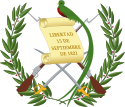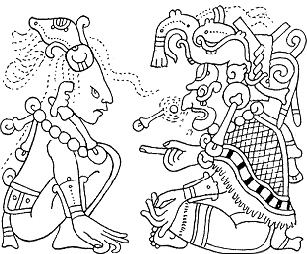
Maya mythology is part of Mesoamerican mythology and comprises all of the Maya tales in which personified forces of nature, deities, and the heroes interacting with these play the main roles. The myths of the Pre-Hispanic era have to be reconstructed from iconography. Other parts of Maya oral tradition are not considered here.

The Mayan languages form a language family spoken in Mesoamerica and northern Central America. Mayan languages are spoken by at least 6 million Maya peoples, primarily in Guatemala, Mexico, Belize and Honduras. In 1996, Guatemala formally recognized 21 Mayan languages by name, and Mexico recognizes eight more within its territory.

Rigoberta Menchú Tum is a K'iche' political and human rights activist from Guatemala. Menchú has dedicated her life to publicizing the rights of Guatemala's indigenous feminists during and after the Guatemalan Civil War (1960–1996), and to promoting indigenous rights in the country.

Mesoamerican calendars are the calendrical systems devised and used by the pre-Columbian cultures of Mesoamerica. Besides keeping time, Mesoamerican calendars were also used in religious observances and social rituals, such as for divination.
Michael D. Coe is an American archaeologist, anthropologist, epigrapher and author. Primarily known for his research in the field of pre-Columbian Mesoamerican studies, Coe has also made extensive investigations across a variety of other archaeological sites in North and South America. He has also specialised in comparative studies of ancient tropical forest civilizations, such as those of Central America and Southeast Asia. He currently holds the chair of Charles J. MacCurdy Professor of Anthropology, Emeritus, Yale University, and is Curator Emeritus of the Anthropology collection in the Peabody Museum of Natural History, where he had been Curator from 1968 to 1994.

The Maya civilization was a Mesoamerican civilization developed by the Maya peoples, and noted for its logosyllabic script—the most sophisticated and highly developed writing system in pre-Columbian Americas—as well as for its art, architecture, mathematics, calendar, and astronomical system. The Maya civilization developed in an area that encompasses southeastern Mexico, all of Guatemala and Belize, and the western portions of Honduras and El Salvador. This region consists of the northern lowlands encompassing the Yucatán Peninsula, and the highlands of the Sierra Madre, running from the Mexican state of Chiapas, across southern Guatemala and onwards into El Salvador, and the southern lowlands of the Pacific littoral plain.
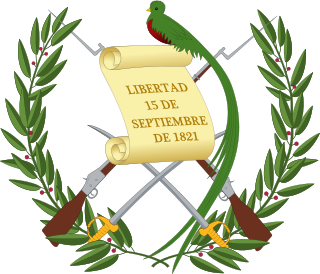
Parliamentary elections were held in Guatemala for half the seats in Congress between 16 and 18 January 1953. The Revolutionary Action Party won a plurality of seats.

Parliamentary elections were held in Guatemala between 24 and 26 January 1947 in order to elect half the seats in Congress. The Revolutionary Action Party won a plurality of seats.
Legislative elections were held in Guatemala to elect members of the Congress on 3–5 November 1944.
A presidential election was held in Guatemala on 17–19 December 1944. The October Revolution of 1944 had overthrown Jorge Ubico, the U.S. backed dictator of Guatemala. A junta composed of Francisco Javier Arana, Jacobo Árbenz and Jorge Toriello took power, and quickly announced presidential elections, as well as elections for a constituent assembly. The subsequent elections took place in December 1944, and were broadly considered free and fair, although only literate men were given the vote. Unlike in similar historical situations, none of the junta members stood for election. The front-runner was the philosophically conservative University professor Juan José Arévalo, of the Renovación Nacional. Arévalo's closest challenger was Adrián Recinos, whose campaign included a number of individuals identified with the Ubico regime. The ballots were tallied on 19 December 1944, and Arévalo won in a landslide, receiving more than four times as many ballots as the other candidates combined.
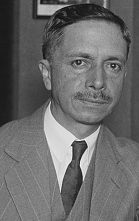
Presidential elections were held in Guatemala between 17 and 19 December 1944. The result was a victory for Juan José Arévalo, who received 86.25% of the vote.

General elections were held in Guatemala on 5 December 1926. The presidential election resulted in a victory for Lázaro Chacón González, who received 88.6% of the vote. Whilst the elections were rigged, the Progressive Liberal Party did manage to win some seats in the Congress.

Awilix was a goddess of the Postclassic Kʼicheʼ Maya, who had a large kingdom in the highlands of Guatemala. She was the patron deity of the Nijaʼibʼ noble lineage at the Kʼicheʼ capital Qʼumarkaj, with a large temple in the city. Awilix was a Moon goddess and a goddess of night, although some studies refer to the deity as male. Awilix was probably derived from the Classic period lowland Maya moon goddess or from Cʼabawil Ix, the Moon goddess of the Chontal Maya.
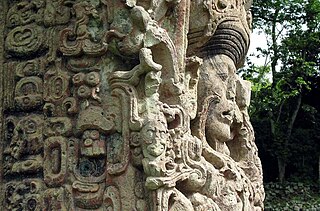
Maya stelae are monuments that were fashioned by the Maya civilization of ancient Mesoamerica. They consist of tall, sculpted stone shafts and are often associated with low circular stones referred to as altars, although their actual function is uncertain. Many stelae were sculpted in low relief, although plain monuments are found throughout the Maya region. The sculpting of these monuments spread throughout the Maya area during the Classic Period, and these pairings of sculpted stelae and circular altars are considered a hallmark of Classic Maya civilization. The earliest dated stela to have been found in situ in the Maya lowlands was recovered from the great city of Tikal in Guatemala. During the Classic Period almost every Maya kingdom in the southern lowlands raised stelae in its ceremonial centre.
The Pan-Mayan Movement is an ethno-political movement among the Maya peoples of Guatemala and Mexico. The movement emerged in the late 1980s and early 1990s in response to a long tradition of the political marginalization of the large indigenous population of Guatemala, and particularly in response to the violent counter-insurgency policies that disproportionately affected indigenous communities during the Guatemalan Civil War. The movement was organized around an ideology seeking to unite the speakers of Guatemala's many Mayan languages under a single shared cultural/ethnic identity. It was an alternative to either of the parties of the civil war - the communist revolutionaries and the conservative government. Indigenous Mayan linguists trained by North American linguists in the Proyecto linguistico Francisco Marroquin played a major role in organizing the movement. With the 1996 peace accords the movement gained a significant position in Guatemalan politics.

The history of Maya civilization is divided into three principal periods: the Preclassic, Classic and Postclassic periods; these were preceded by the Archaic Period, which saw the first settled villages and early developments in agriculture. Modern scholars regard these periods as arbitrary divisions of chronology of the Maya civilization, rather than indicative of cultural evolution or decadence. Definitions of the start and end dates of period spans can vary by as much as a century, depending on the author. The Preclassic lasted from approximately 2000 BC to approximately 250 AD; this was followed by the Classic, from 250 AD to roughly 950 AD, then by the Postclassic, from 950 AD to the middle of the 16th century. Each period is further subdivided:
The Título Cʼoyoi is an important early colonial Kʼiche document documenting the mythical origins of the Kʼicheʼ people and their history up to the Spanish conquest. It describes Kʼicheʼ preparations for battle against the Spanish, and the death of the Kʼicheʼ hero Tecun Uman. The document was written in Qʼumarkaj, the Kʼicheʼ capital city, by the Cʼoyoi Sakcorowach lineage, which belonged to the Quejnay branch of the Kʼicheʼ, and who held territory just to the east of Quetzaltenango, now in Guatemala. The document was largely written by Juan de Penonias de Putanza, who claimed to be the relative of a Cʼoyoi nobleman who was killed during the Spanish conquest. It was composed with the assistance of the Kʼicheʼ officialdom at Qʼumarkaj, and portions of the text reflect the official version of Kʼicheʼ history as produced in the capital. An illustration in the document shows that the Maya nobility of Quetzaltenango adopted the double-headed Hapsburg Eagle as their family crest.
In 1712, a number of Maya communities in the Soconusco region of Chiapas rose in rebellion, in what is known as the Tzeltal Rebellion or Tzendal Rebellion. It was a multiethnic revolt, with 32 towns of Tzeltal (14), Tzotzil (15), and Chol (3) indigenous peoples participating in it. The indigenous renounced the authority of the Catholic hierarchy and established a priesthood of indigenous men. There was widespread military mobilization of indigenous men, who called themselves “soldiers of the Virgin.”
